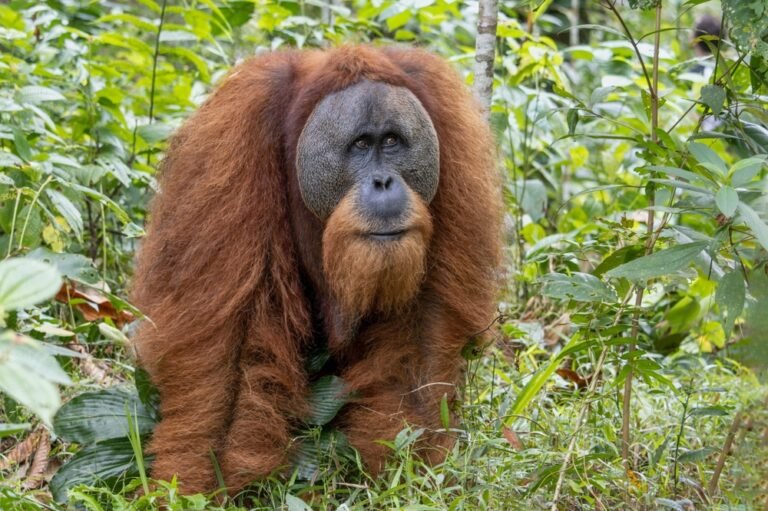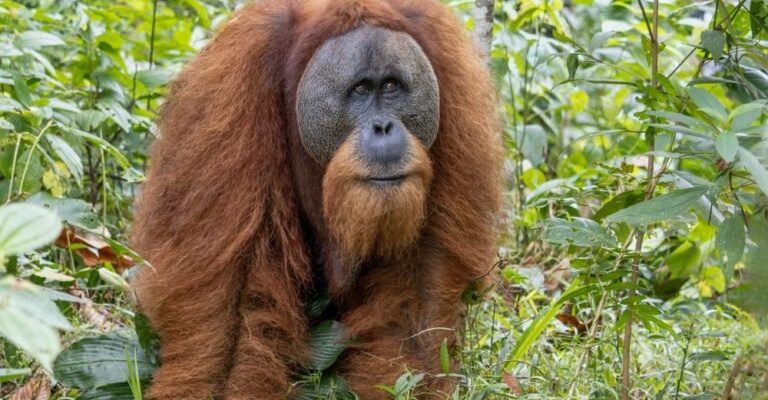
You might be wondering how something so majestic can be on the brink of extinction. Unfortunately, habitat loss, illegal logging, and climate change are a few hurdles that the Tapanuli orangutan is grappling with. Let’s dive deeper into what makes this orangutan so special, the threats it faces, and what conservation efforts are out there to help it thrive.
What Makes the Tapanuli Orangutan Unique?
The Tapanuli orangutan is not just another type of orangutan; it’s a distinct species with its own genetic makeup and behaviors. Found only in a small region of Sumatra, these orangutans have adapted to their environment in ways that set them apart from their cousins, the Sumatran and Bornean orangutans. Imagine living in a tiny island of trees where every branch and leaf feels like home. That’s what Tapanuli orangutans experience.
These orangutans are characterized by their unique fur color, which ranges from bright orange to dark brown, making them stand out in the lush green canopy. They have longer faces and a stockier build compared to their relatives. With a diet consisting mainly of fruit, they play a crucial role in their ecosystem by helping to disperse seeds. So, every time they munch on a juicy fig, they’re also planting the seeds for future trees—pretty cool, right?
Yet, their limited habitat is a significant concern. Tapanuli orangutans live in the Batang Toru ecosystem, which spans only about 1,200 square kilometers. This tiny range makes them particularly vulnerable to environmental changes and human activities.
Why are Tapanuli Orangutans Endangered?
The Tapanuli orangutan is classified as critically endangered, which places it at high risk of extinction. You might be asking why? Well, the answers lie in a combination of factors. One of the biggest threats is habitat destruction. The forests they call home are being cleared for palm oil plantations and logging. Imagine a cozy living room being turned into an empty lot; that’s what these orangutans are facing each day.
Additionally, climate change is a silent killer. As temperatures rise and rainfall patterns shift, the forests are changing in ways that aren’t favorable for them. With fewer trees and food sources, these orangutans are struggling to survive. It’s like trying to live in a garden that’s slowly turning into a desert.
Lastly, hunting and poaching are serious issues. Although it’s illegal to kill orangutans, the demand for bushmeat and wildlife products still exists. Every time an orangutan is hunted, it not only diminishes the population but also disrupts the delicate balance of the ecosystem they help maintain.
Conservation Efforts: What’s Being Done?
Fortunately, there’s hope! There are various conservation efforts underway to help protect the Tapanuli orangutan and its habitat. Organizations like the Sumatran Orangutan Conservation Program (SOCP) are actively engaging in rehabilitation and reforestation efforts. They work to rescue orangutans that have been displaced by habitat destruction and provide them with a safe space to recover.
Moreover, awareness campaigns are crucial. By educating local communities about the importance of orangutans and their role in the ecosystem, conservationists are fostering a sense of ownership and responsibility. It’s much like teaching someone to take care of their garden—they’re more likely to nurture it if they understand its value.
On a larger scale, there are calls for stronger laws and enforcement against illegal logging and hunting. Governments and NGOs are partnering to create protected areas where these orangutans can thrive without the constant fear of habitat loss or poachers.
The Role of the International Community
The conservation of the Tapanuli orangutan isn’t just a local issue; it requires global attention. International organizations are crucial allies, providing funding, expertise, and advocacy to protect these endangered beings. Through collaboration, countries can develop strategies to combat illegal wildlife trade and promote sustainable land use practices.
Here’s the thing: when you invest in conservation, you’re not just saving a species; you’re helping entire ecosystems that sustain countless life forms. A healthy forest contributes to air quality, soil stability, and climate regulation, which ultimately affects us all.
Challenges Ahead: What Can We Do?
While there’s progress, challenges remain. One of the biggest hurdles is balancing development and conservation. As Indonesia grows economically, the demand for land increases. It’s a tough tug-of-war between conservation needs and economic growth.
Individuals can play an important role too! Supporting ethical products, like sustainably sourced palm oil, or even donating to conservation efforts can make a difference. Think of it as voting with your wallet; every small choice can add up to significant change.
Furthermore, spreading awareness about the Tapanuli orangutan can rally more people to the cause. When people learn about this unique orangutan and its struggles, they’re more likely to care and push for action. Sharing articles, participating in conservation programs, or even just having conversations can ignite a ripple effect of positivity.
The Tapanuli orangutan’s plight is a reminder that our planet’s unique species need our help. It’s easy to feel overwhelmed when you think about the challenges they face, but every bit of awareness and effort counts. From supporting conservation organizations to making informed consumer choices, we all have the power to contribute to a brighter future for these amazing creatures.
In a world where the balance of nature is increasingly disrupted, the survival of the Tapanuli orangutan is a shared responsibility. So, let’s rally together, educate ourselves and others, and work towards a world where these magnificent creatures can swing freely through their treetop homes for generations to come. After all, isn’t it our job to protect the wonders of nature?

